Titanic
Timeline to Disaster
|
| |
"Iceberg, Right Ahead!!"
It was 11:40 pm on
April 14, 1912, when those fateful words rung out on the
bridge of the Titanic.
Reacting quickly,
First Officer
Murdoch ordered an abrupt turn to port and full speed
astern, which reversed the engines driving the outer
propellers.
Thanks to the sharp turn, the
ship's starboard side
clearly missed the visible part of the
iceberg. However beneath the water, the massive
iceberg was much wider.
The underside of the Titanic brushed
against the deadly edges of
the iceberg. This buckled
the hull in several places and popped
out rivets below the waterline. The
glancing blow created a
total of six leaks in the first five watertight
compartments. Murdoch then ordered hard right rudder, which
swung Titanic's stern away from the iceberg.
The fifth
compartment was breached for only 10-15 feet,
but this was the killer blow. The
watertight doors were shut as water started filling the five
compartments - one more than Titanic could stay afloat with.
|
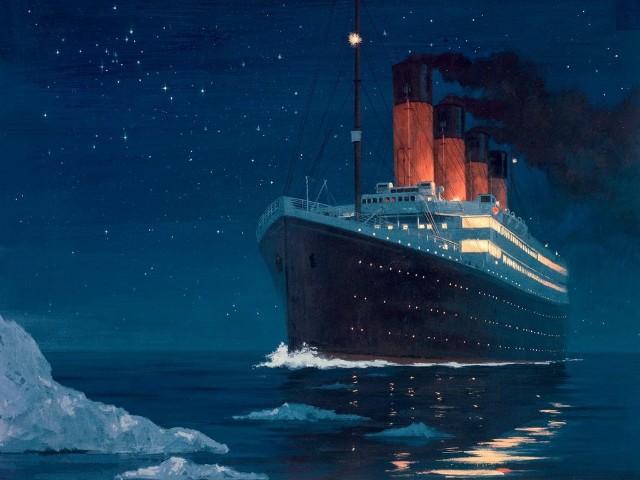 |
Two and a half hours later, the Titanic would disappear
beneath the freezing waters of the Northern Atlantic.
The Titanic carried 20
lifeboats with a total capacity of 1,178 persons.
There were 2,223 people on board.
This meant that automatically over a thousand people were
surely doomed to
die. However, due to extreme incompetence
on the part of the staff in dealing with the lifeboats, the death
total was far worse. Of a total of
2,223 people, only 706 survived; 1,517 perished.
Thanks to James Cameron's
Oscar-winning 1997 movie, most of us are keenly aware of the
extent of the tragedy.
"It is unsinkable! God
Himself couldn't sink this ship!!"
Titanic was the
largest passenger steamship ever built at the time. Thanks to
improvements in engineering design, the ship was
said to be unsinkable.
Sadly the iceberg proved
that theory incorrect. The shock of hearing the
Titanic had sunk was so profound that now a hundred years
later, every time something goes wrong, we refer to it as
"Titanic Disaster" or a "Titanic Upset". The Titanic
simply wasn't supposed to vulnerable.
It was an
important event because so many people died when the ship
sank, due mainly to the lack of
lifeboats. After the sinking,
no ship was ever again allowed to set sail unless there were enough lifeboats for
everyone on the ship. The sinking
of the Titanic is still considered the deadliest
peacetime ocean disasters
of all time.
Forward
On the night of
April 14-15, 1912, Titanic struck an iceberg and sank.
In casualties alone, this disaster ranks as one
of the worst peacetime maritime disasters in history.
In terms of significance and drama, the
Titanic is the most famous
disaster in modern history.
Built in Belfast,
Ireland, the Titanic was the largest passenger steamship in
the world at the time of her sinking.
During Titanic's
maiden voyage from England to New York, she struck an
iceberg at 11:40 p.m. on Sunday evening April 14, 1912.
Two
hours and forty minutes later, the enormous ship split into
two pieces and sunk at 2:20 a.m. Monday morning, April 15.
|
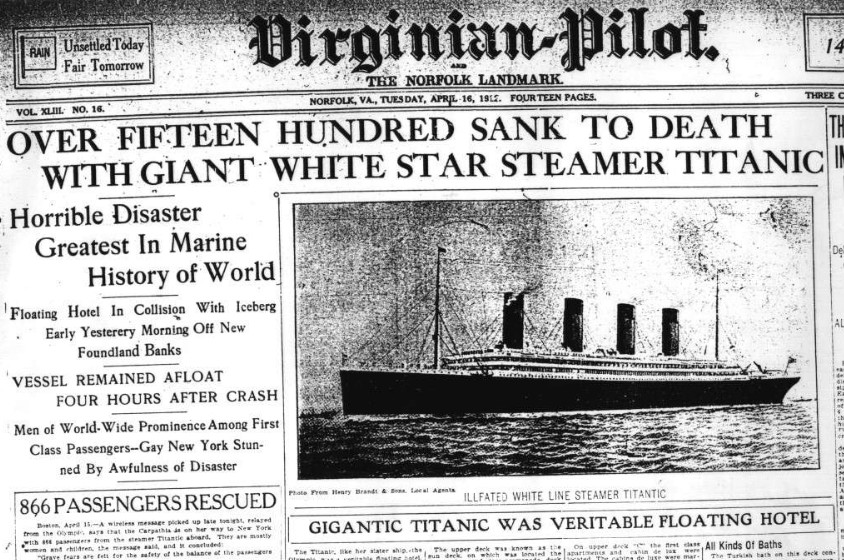 |
| |
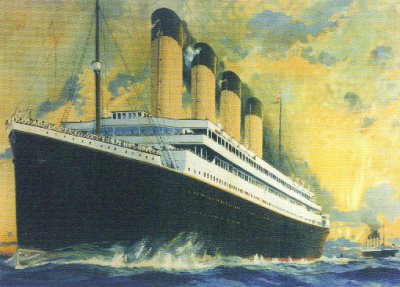 |
The irony behind this
horrible accident was that the Titanic was considered to be a
pinnacle of naval architecture and technological achievement.
In an article prior to its voyage,
Shipbuilder Magazine labeled the Titanic "practically unsinkable."
Titanic's design used some of the most advanced technology available
at the time. Therefore it was a great shock that, despite the
advanced technology and experienced crew, Titanic sank with a great
loss of life.
She was divided into 16
compartments by doors, which could be closed by means of a switch on
the bridge. However, the ship had at least one
weakness. The watertight bulkheads did not reach the
entire height of the decks, only going up as far as E-Deck.
This meant the Titanic could stay afloat
with any two of her compartments flooded, or with eleven of fourteen
possible combinations of three compartments flooded, or with the
first/last four compartments flooded: any more and the ship would
sink.
|
It was practically impossible to conceive
of a scenario whereby this many compartments might be
compromised. In fact, some say the ship might have survived
if she had hit the iceberg head on because her design took
this possibility into account. By turning the ship in
a last minute attempt to avoid it, the ship sailed right
beside iceberg which allowed it to tear not a deep hole, but
a long hole in practically the worst spot of all - right in
the middle of the ship's side.
The
Titanic carried 2,223 people on
its maiden voyage.
In the
accident, more than two-thirds of these people lost their
life.
It makes you wonder why the Titanic was considered
the world’s safest ship at the time.
|
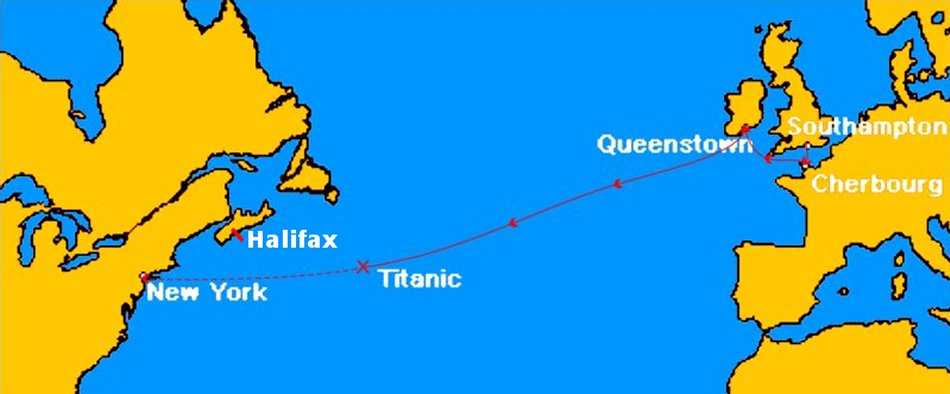 |
|
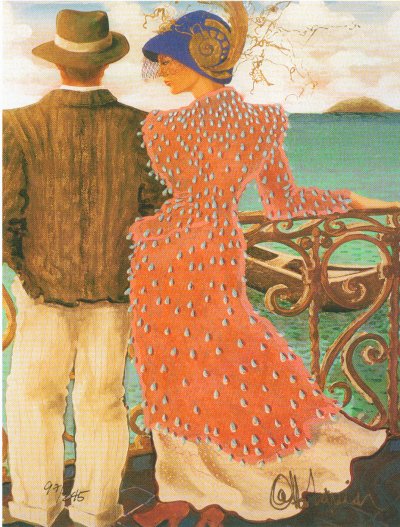 |
Besides its ‘unsinkable
status’, another factor that added to the sensation of this tragic
event is that the Titanic carried a veritable “Who’s Who” aboard its
ill-fated first trip. Some of the most prominent people in
America were on board in first class.
These included millionaire John Jacob Astor IV and his pregnant wife
Madeleine; industrialist Benjamin Guggenheim; Macy's department
store owner Isidor Straus and his wife Ida; Denver millionaire
Margaret "Molly" Brown and many others.
Also traveling in first
class were White Star Line's managing director J. Bruce Ismay, who
survived, and the ship's builder Thomas Andrews, who was on board to
observe any problems and assess the general performance of the new
ship.
It could have been even worse. Two of the
country’s most famous businessmen, J.P. Morgan and Milton Hershey,
had plans to travel on the Titanic but cancelled their reservations
before the voyage.
There
were many factors that have made the Titanic Tragedy
persistently famous in the years since.
To begin with, there were the improbable odds against the ship
sinking and the unusually high percentage of people who died.
Thanks to the media frenzy about
Titanic's famous victims, this story became
well-documented thanks to the survivors.
When one factors in the
legends about what happened on board the ship
including the heroes and the selfish, the drama was elevated to the
level of a Greek Tragedy. This story literally drips with irony
due to the insanity of the
lifeboat situation plus the cruel
negligence of a nearby ship which could have come to the rescue.
|
In the mid part of the Twentieth
Century, the story
finally began to fade in memories.
However, the 1955 publication of Walter Lord's "A Night to
Remember" brought the story back to forefront. Thanks
to Lord's extensive interviews with many of the survivors
plus an excellent job of retelling the story, new details
came to light. When this excellent account of the
tragedy was made into a movie by the same name in 1958,
public interest in the Titanic tragedy quickly came back to
life.
25 years later, just when interest began
to wane again, the drama surrounding Robert Ballard's discovery of the wreck
location in 1985 brought all the
fascination right back to the surface.
Twelve years after Ballard's
discovery, the
hoopla surrounding James Cameron's sensational movie was all
it took to bring this story front and center to a modern
audience. Combining the fictional romance
of Jack and
Rose with riveting scenes recreating the horror of the
sinking in unbelievable detail, Cameron's Titanic
made the doomed ship practically a household word at the
start of the new Millennium.
In April 2012, two cruise ships, one
departing from Southampton, UK, and one from New York City,
sailed to the North Atlantic. Meeting at the ocean
grave site of the Titanic on 100th anniversary of the
disaster, not were the passengers able to show their
respects, but the accompanying media beamed images of the
Memorial ceremony around the world.
Today there is no question the Titanic
Disaster remains the most famous disaster of all time.
|
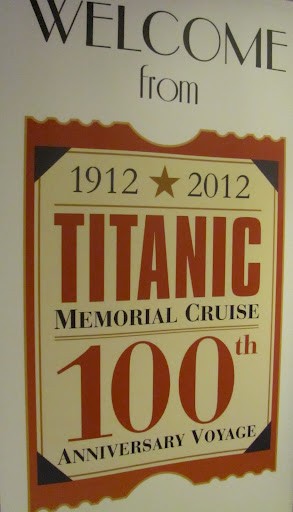 |
|
| |
Titanic
Timeline to Disaster
|
1:45
PM - Amerika iceberg warning
On the night of
Sunday, April 14, 1912, the temperature had dropped to near
freezing and the ocean was completely calm. There was no moon and the sky was clear.
Surviving 2nd
Officer Charles Lightoller later wrote, "the sea was like
glass".
|
Captain
Edward Smith, perhaps in response to iceberg
warnings received by wireless over the previous few
days, had altered Titanic's course around 10 miles
(18 km) south of the normal shipping route. That
Sunday at 1:45 p.m., a message from the steamer SS Amerika warned that large icebergs lay south of
Titanic's path but the warning was addressed to the USN
Hydrographic office and was never relayed to the bridge.
Iceberg warnings were received throughout the day and were
quite normal for the time of year. Later that evening at
9:30 pm, another report of numerous, large icebergs in
Titanic's path was received by Jack Phillips and Harold
Bride in the radio room, this time from the Mesaba, but this
report also did not reach the bridge.
Although there
were warnings, there were no operational or safety reasons
to slow down or alter course. The Titanic had three teams of
two lookouts high up in the "Crow's nest" who were rotated
every two hours. On any other night it is almost certain
they would have seen the iceberg in time.
However, a combination of factors worked against them: with
no moon, no wind and the dark side of the berg facing the
ship, the lookouts were powerless. Had they spotted the
iceberg 10 seconds later or 10 seconds earlier, or even had
the ship simply hit it straight on, it is likely that
Titanic would not have foundered.
But as Lightoller stated at the American inquiry,
"Everything was against us that night.
|
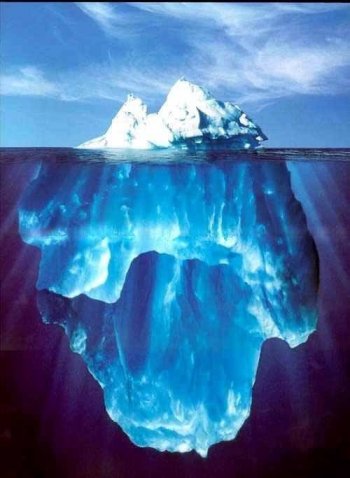 |
 |
11:40 PM -
"Iceberg, right ahead!"
At 11:40 p.m. while
sailing south of the Grand Banks of Newfoundland, lookouts Frederick
Fleet and Reginald Lee spotted a large iceberg directly ahead of the
ship. Fleet sounded the ship's bell three times and telephoned the
bridge.
Sixth Officer Moody answered, "Yes, what do you see?",
He heard Fleet
exclaiming, "Iceberg, right ahead!"
Moody responded "Thank
you".
He then informed First Officer Murdoch of the call. Murdoch (who had
now already seen the iceberg) ordered an abrupt turn to port and full speed astern, which reversed the engines driving the outer
propellers (the turbine driving the centre propeller was not
reversible).
30 seconds passed. Thanks
to the sharp turn, the ship's starboard side
clearly missed the visible part of the iceberg.
However beneath the water, the massive iceberg was much wider.
|
| |
The underside of the Titanic brushed
against the deadly edges of
the iceberg. This buckled the hull
in several places and popped out rivets
below the waterline. The glancing blow created a total of six leaks in the first
five watertight compartments. Murdoch then ordered hard right
rudder, which swung Titanic's stern away from the iceberg.
The fifth
compartment was breached for only 10-15 feet,
but that was the killer blow. The
watertight doors were shut as water started filling the five
compartments - one more than Titanic could stay afloat with.
Within 10 minutes, six watertight
compartments flood, sealing the ship's fate.
At 11:50 pm, the ship's mail
department down on G deck in the forward part of the ship
now stands in two feet of water. Five postal clerks
struggle mightily to transfer the ship's voluminous amount
of mail coming to America from Europe to the boat deck for
loading into a lifeboat.
|
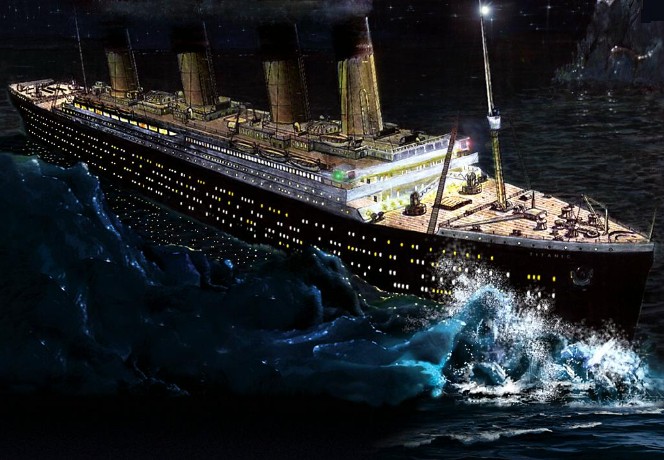 |
|
|
|
| |
Captain Smith, alerted by the jolt of the impact, ordered
"all-stop" once he arrived on the bridge.
Smith asks Thomas Andrews, the man most familiar
with the Titanic's design, to go down and inspect the damage.
Following an
inspection by the ship's senior officers, the ship's
carpenter and Thomas Andrews, which included a survey of the
half-flooded two-deck postal room, it was apparent that the
Titanic would sink. At Midnight,
Andrews reports to Smith the ship has about two hours till sinking.
At
12:02 am, Smith orders Chief Officer Wilde and Second Officer
Lightoller to uncover the lifeboats and prepare for loading.
At
12:14 am, Captain Smith informs wireless operater Phillips, "We've
struck an iceberg," and asks him to send a CQD distress call.
Cape Race Newfoundland hears MGY, Titanic's call letters, giving her
position.
At
12:25 am, Harold Cottam, Carpathia's wireless operator
receives the Titanic's distress call. It says "Come at once. We have
struck a berg. It's a CQD-OM Position 41.46 N, 50.14 W".
Cottam
immediately notifies Captain Arthur Rostron, commander of the Cunard
liner which is headed for the Mediterranean with 743 passgengers.
Rostron calculates that the Titanic is 58 miles away and
orders the crew to change course and prepare the ship for survivors.
The vessel's normal running speed of 12.5 knots steams to an
incredible 17.5
At 12:30 am,
50 minutes after the collision, Captain Smith
ordered the lifeboats prepared for boarding.
At
12:47, Fourth Officer Joseph Boxhall fired the first white
distress rocket. Seven more will be
discharged at five to ten minute intervals. The last rocket is
fired is fired at 1:40 am. This is a desperate attempt to
alert the nearly Californian of the Titanic's distress; alas
it is all in vain.
|
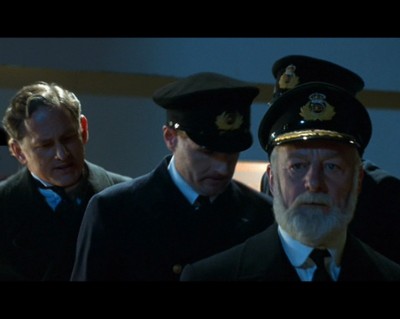
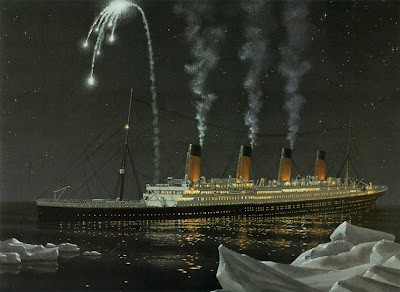 |
|
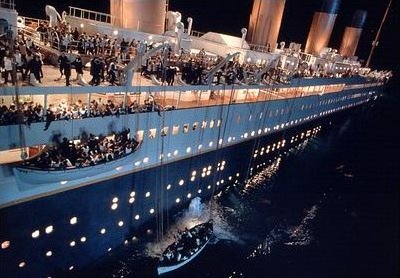 |
12:45 AM -
First lifeboat lowered
At
12:45 am, on
the starboard side forward, the first lifeboat, Boat #7, is lowered
only half-full with 32 passengers. The Titanic carried 20
lifeboats with a capacity of 1,178.
There were 2,223 people on board.
Automatically 1,000 people were doomed to
die.
What were they thinking?
Thirty-two lifeboats had been originally specified, but management
decided the doubled-up boats spoiled the sight lines of the
luxury ship. Their conceit about the invincibility of the
Titanic prevented them from conceiving this kind of a
disaster. They assumed that in case of an accident, the
Titanic would float long enough to permit an organized rescue.
Sixteen lifeboats, indicated by number, were in the davits; and four
canvas-sided collapsibles, indicated by letter, stowed on the roof
of the officers' quarters or on the forward Boat Deck to be launched
in empty davits.
|
With only enough
space for a little more than half the passengers and crew,
Titanic carried more boats than required by the British
Board of Trade. At the time, the number of lifeboats
required was determined by a ship's gross tonnage, rather
than its human capacity. The regulations concerning lifeboat
capacity had last been updated in 1894, when the largest
ships afloat measured about 10,000 gross tons,
compared to Titanic's 46,328 tons.
Once the passengers realized the Titanic had no
chance to stay afloat, there
was a great deal of panic. First and
second-class passengers had easy access to the lifeboats
with staircases that led right up to the boat deck, but
third-class passengers found it much harder. Many found the
corridors leading from the lower sections of the ship
difficult to navigate and had trouble making their way up to
the lifeboats. Some gates separating the third-class section
of the ship from the other areas, like the one leading from
the aft well deck to the second-class section, are known to
have been locked.
|
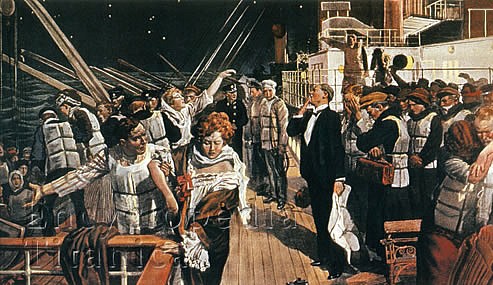 |
While the majority of first and second-class
women and children survived the sinking, more
third-class women and children were lost than saved.
The locked 3rd class gates were the result of
miscommunication between the boat deck and F-G
decks.
Titanic history tells us
that gates did exist which barred the third class
passengers from the other passengers. However, these
gates weren't in place to stop a third class
passenger from taking a first class passenger's seat
on a lifeboat. Instead, the gates were in place as a
regulatory measure to prevent the "less cleanly"
third class passengers from transmitting diseases
and infections to the others. This would save time
when the ship arrived in New York, as only the third
class passengers would need a health inspection.
At the time of the sinking, some stewards kept gates
locked waiting for instructions, while others
allowed women and children to the upper decks. As a
result of poor communication from the upper decks,
the dire reality of the situation was never
conveyed. The crew failed to search for passengers
in the cabins and common areas, and the fact that
some third class passengers did not speak English,
also presented a problem. As a result, many of the
third class passengers were left to fend for
themselves. Only 25 percent of the third class
passengers survived the disaster.
At 1:30
am, Boat #15, the last lifeboat on the starboard
side aft, is lowered. It is filled mainly with
Third Class passengers and eleven crewmen.
Lifeboats were supposed to be lowered with women
and children from the boat deck and then subsequently to pick up F-G
deck women and children from open gangways. Unfortunately, with no
boat drill or training for the seamen, the boats were simply lowered
into the water without stopping.
|
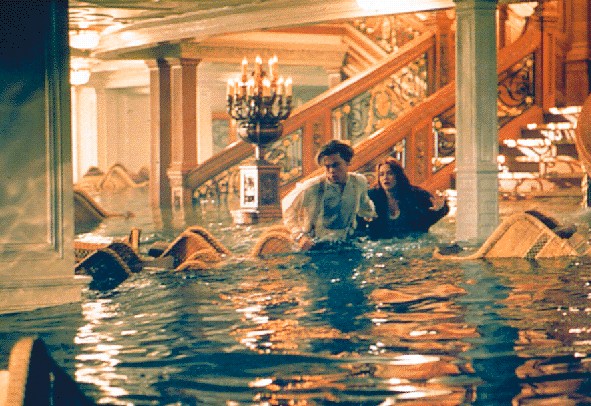 |
Titanic
continued to report its
position. Wireless operators Jack Phillips and Harold Bride were
busy sending out distress signals. The message was "SOS-MGY,
sinking, need immediate assistance."
At
12:50 am, the White Star Celtic reported receiving the
signal.
At
1:25 am, the Titanic's sister ship Olympic was in contact.
Several ships responded,
including Mount Temple and Frankfurt,
but none were close enough to make it in time. The Olympic
was over 500 nautical miles away.
The closest ship to
respond was Cunard Line's RMS Carpathia.
Unfortunately it was too far away to save the day completely.
At 58
nautical miles (107 km) away, it would arrive in about four hours,
too late to get to Titanic in time to save the many passengers who
stayed on the ship or those who died in the frozen waters.
|
|
|
|
|
|
A Tragic Missed Opportunity
Two land–based
locations received the distress call from Titanic. One was
the wireless station at Cape Race, Newfoundland, and the
other was a Marconi telegraph station on top of the
Wanamaker's department store in New York City.
Shortly after
the distress signal was sent, a radio drama ensued as the
signals were transmitted from ship to ship, through Halifax
to New York, throughout the country. People began to show up
at White Star Line offices in New York almost immediately.
From the bridge,
the lights of a ship could be seen off the starboard side
approximately 10-15 miles away. Since it was not responding
to wireless, nor to the distress rockets being launched
every 15 minutes or so, Fourth Officer Boxhall and
Quartermaster Rowe attempted signaling the ship with a Morse
lamp, but the ship never appeared to respond.
This was the
SS Californian, the ship whose negligence added to the
immensity of the tragedy.
|
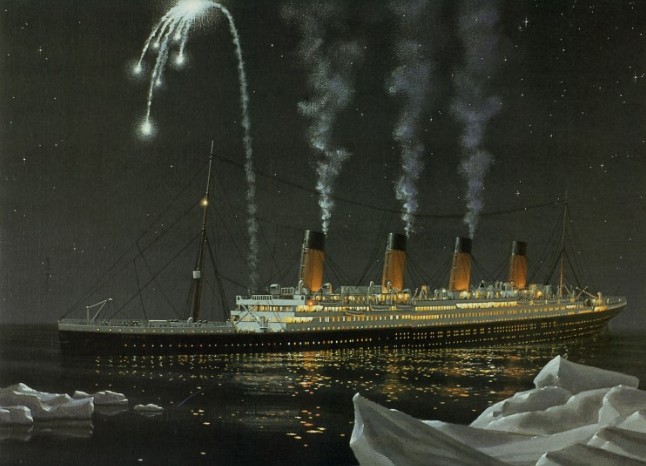 |
The Californian was nearby the Titanic. The ship had dropped
anchor for the night because of ice. Its wireless was turned
off because the wireless operator had gone to bed for the
night.
The Titanic's wireless set had broken down earlier that day.
Jack Phillips and Harold Bride had spent most of the day
fixing it. As a result, they were extremely backlogged in
their sending of messages. Finally they got it working
again. Now with the set fixed and a strong signal available
from the Halifax station, Phillips was getting some work
done.
Just before he went to bed at around 11:00 p.m.,
Californian's radio operator Cyril Evans attempted to warn
Titanic that there was a large field of ice ahead. But he
was cut off by an exhausted Jack Phillips aboard the
Titanic, who sent back, "Shut up, shut up! I am busy, I am
working Cape Race."
Minutes later,
two officers on the Californian, 2nd Officer Stone and
Apprentice Gibson, noticed a ship approaching at around
11:00 pm. They noticed her stop and then about an hour
later noticed her beginning to send up rockets. They
informed Californian Captain Stanley Lord.
The rockets Titanic sent up had the color of distress
rockets for White Star Line. However, due to a lack of
uniformity in Naval regulations at that time, Captain Lord
was confused. He did not know they were distress rockets.
Instead he said "Keep watching it" and then went back to
sleep. Even though there was much discussion about the
mysterious ship, which the officers on duty thought to be
moving away before disappearing, the crew of Californian did
not wake its wireless operator until morning.
|
| |
|
2:00 AM - Waterline reaches forward boat deck
|
The first
lifeboat was lowered shortly after 12:45 a.m. on the
starboard side. There were only 28 people on board out of a
maximum capacity of 65.
At first,
passengers were reluctant to leave the warm, well-lit and
ostensibly safe Titanic. The ship initially showed no
outward signs of being in imminent danger which made them
reluctant to board small, unlit, open lifeboats. This was
one of the reasons most of the boats were launched partially
empty: they were pressed for time and it was hoped that many
people would eventually jump into the water and swim to the
boats later on.
Obviously the flaw in this thinking is that the boats
quickly moved to a safe distance from the Titanic in case of
an explosion.
Also important
was an uncertainty regarding the boats' structural
integrity; it was feared that the boats might break if they
were fully loaded before being set in the water. Captain
Smith ordered the lifeboats be lowered half empty in the
hope the boats would come back to save people in the water,
and some boats were given orders to do just that.
One boat,
boat number one, meant to hold 40 people, left Titanic with
only 12 people on board. It was rumored that Lord and Lady
Duff Gorden bribed 7 crew members to take them and their 3
companions off the ship.
|
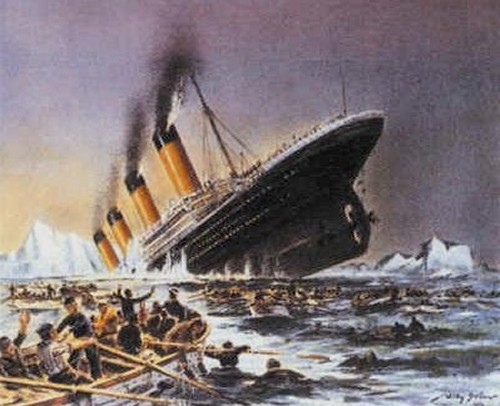 |
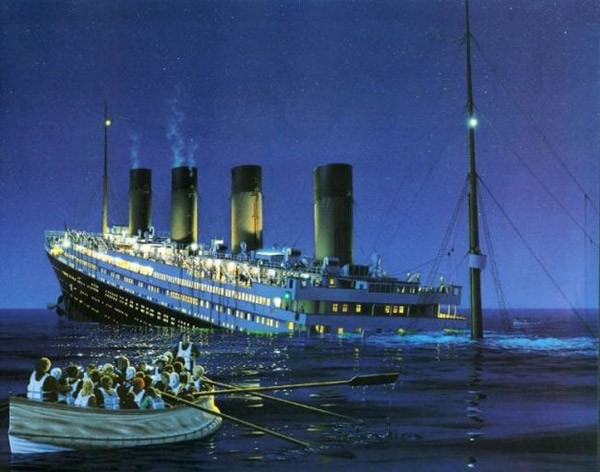 |
Bruce Ismay, managing director of
the White Star Line, left on Collapsible Boat C.
Ismay was
later criticized by both the American and British Inquiries
for not going down with the ship.
As the ship's
tilt became more apparent, people started to become nervous.
Now some of the lifeboats began leaving fully loaded.
"Women
and children first" remained the imperative for loading the
boats. In reality, despite this slogan, a higher proportion
of First-Class men survived than Third-class women and
children, many of whom remained trapped below.
Shortly after
2:00 a.m. the waterline reached the bridge and forward boat
deck. All the lifeboats, save for the awkwardly located
Collapsibles A and B, had been lowered. Collapsible D, with
44 of its 47 seats filled, was the last lifeboat to be
lowered from the davits.
The total number of vacancies in the
lifeboats was estimated at
close to 475.
|
2:10 AM -
The stern rises out of water
Around 2:10 a.m., the
stern rose out of the water, exposing the propellers, and the
forward boat deck was flooding.
Water had begun to pour into the ship, drowning
many of the people still trapped on the lower decks.
The last two lifeboats floated right off the deck as the
ocean reached them: collapsible lifeboat B upside down, and
collapsible lifeboat A half-filled with water.
Shortly afterwards the first funnel fell forward, crushing part of
the bridge and many of those struggling in the water.
On deck, people scrambled towards the stern or jumped overboard in
hopes of reaching a lifeboat.
As the ship's
stern continued to slowly rise into the air, everything not
secured crashed towards the bow. The electrical system
finally failed and the lights, which had until now burned
brightly, went out.
Titanic's second funnel broke off and fell into the water,
and Titanic herself tore apart.
|
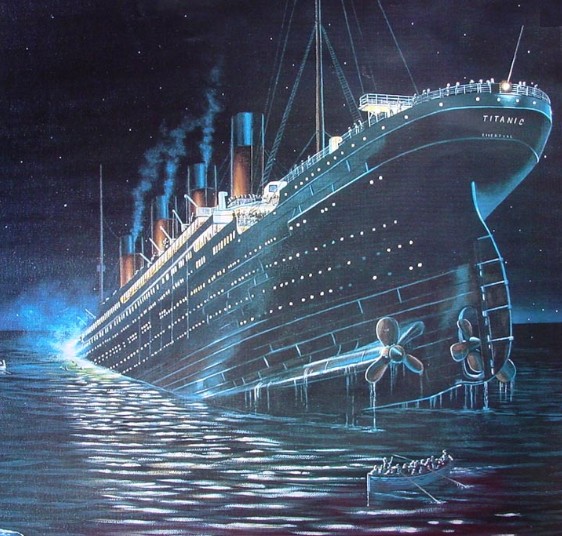 |
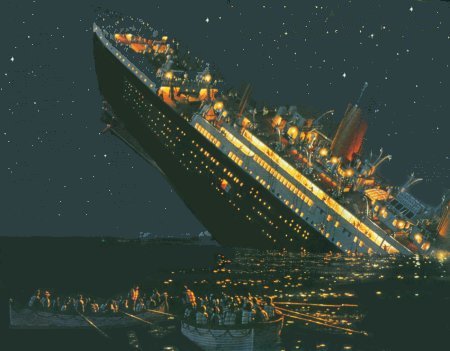 |
2:20 AM -
The Titanic sinks
Stress on the hull caused
Titanic to break apart into two large pieces, between the third and
fourth funnels, and the bow section went completely under. The stern
section briefly righted itself on the water before rising back up
vertically. After a few moments, the stern section also sank into
the ocean about two hours and forty minutes after the collision with
the iceberg.
White Star attempted to
persuade surviving crewmen not to state that the hull broke in half.
The company believed that this information would cast doubts upon
the integrity of their vessels.
In fact, the stresses inflicted on
the hull when it was almost vertical (bow down and stern in the air)
were well beyond the design limits of the structure and no
legitimate engineer could have fairly criticized the work of the
shipbuilders in that regard.
|
As the ship sank
into the depths, the two sections ended their final plunges
very differently. The streamlined bow planed off
approximately 2,000 feet (600 m) below the surface and
slowed somewhat, landing relatively gently. The stern fell
fairly straight down towards the ocean floor, possibly
rotating as it sank, with the air trapped inside causing
implosions.
It was already half-crushed when it hit bottom
at high speed; the shock caused everything still loose to
fall off. The bow section however, having been opened up by
the iceberg and having sunk slowly, had little air left in
it as it sank and therefore remained relatively intact
during its descent.
|
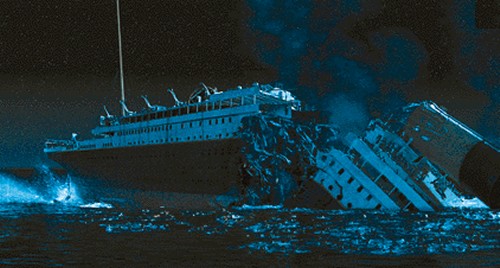 |
4:10 AM -
Carpathia picks up first lifeboat
Unfortunately, it is too late to help most
of the victims.
|
Two
hours after Titanic sank, RMS Carpathia, commanded by Captain Arthur
Henry Rostron, arrived on scene. It picked
up the first lifeboat at 4:10 AM.
Even though the
Californian was much closer, their wireless operator had gone to bed
for the night. As a result the crew was
largely (but not totally) ignorant of the tragedy unfolding
just six miles away.
Over the next
hours, the remainder of the survivors were rescued.
Among the survivors were
several dogs brought aboard in the hands of the first class
passengers. They were found in the
lifeboat sitting in the laps of their owners.
On board Carpathia, a short prayer service for the
rescued and a memorial for the people who lost their lives
was held, and at 8:50 a.m. Carpathia left for New York,
arriving on April 18.
|
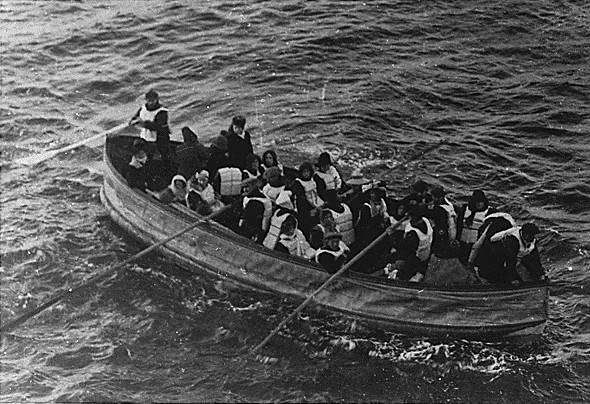 |
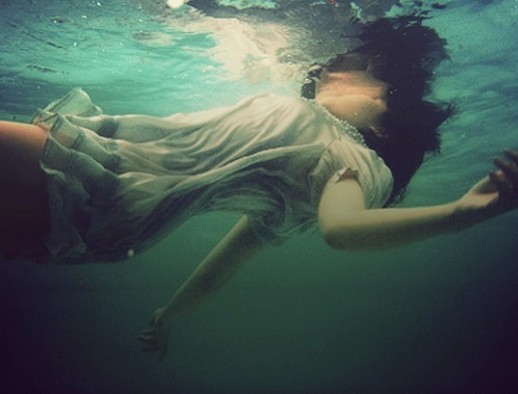 |
Once the loss of life was verified, White Star Line
chartered the ship MacKay-Bennett to retrieve bodies.
The Mackay-Bennett sailed from
Halifax, Nova Scotia at 12:28 p.m. on Wednesday,
17 April 1912.
Upon reaching the wreck site, it quickly became apparent
that there were far more bodies floating in the ocean than
anyone had ever expected. It did not take long for
White Star Line officials to conclude that a second vessel
would be required and arrangements were made to charter the
cable steamer Minia to assist the Mackay-Bennett.
A total of 328
bodies were eventually recovered. Many of the bodies were
taken to Halifax, Nova Scotia where the majority of the
unclaimed were buried in Fairview Cemetery.
|
|
|
|
|
Death Toll
Only 12 survivors were recovered from the water by the
Carpathia.
The majority of deaths were caused by victims succumbing to
hypothermia in the 28 °F (-2 °C) water.
The selfishness of the survivors didn’t help. Only one
lifeboat in 20 came back to the
scene of the sinking to attempt to rescue survivors.
Lifeboat 4 was close by and picked up eight crewmen, two of
whom later died.
There were some arguments in some of the other lifeboats
about going back, but many survivors were afraid of being
swamped by people trying to climb into the lifeboat or being
pulled down by the anticipated suction from the sinking
ship, though this turned out not to be severe.
Another boat helped as well.
Close to an hour later, after tying 3 or 4 lifeboats
together on the open sea (a difficult task), Lifeboat 14
went back looking for survivors and rescued four people.
Sadly, one of the 14 died
afterwards from exposure to the cold
water.
|
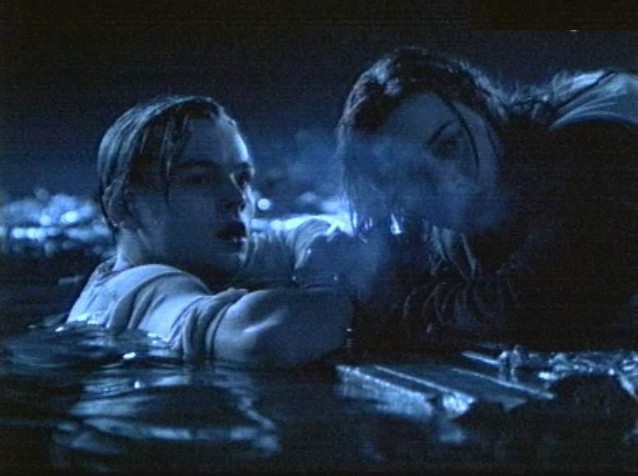 |
Of a total of
2,223 people, only 706 survived; 1,517 perished.
If the
lifeboats had been filled to capacity, 1,178 people could
have been saved.
Of the First
Class, 199 were saved (60%) and 130 died.
Of the Second Class, 119 (44%) were saved and 166 were lost.
Of the Third Class, 174 were saved (25%) and 536 perished.
Of the crew, 214 were saved (24%) and 685 perished.
1,347 men (80%) died, and 103 women (26%) died.
53 children (about 50%) also died.
Of particular note, the entire complement of the Engineering
Department remained at their posts
to keep the ship's electrical systems running.
They all drowned.
Lifeboat Collapsible B was the last boat to
be launched during the sinking of the Titanic.
The boat is famous for carrying, among others, Charles
Lightoller, second officer and the most senior crewmember to survive
the sinking; wireless operators Harold Bride and Jack Phillips (who
would later die on board the collapsible), and Sid Daniels, the last
surviving crewmember of the RMS Titanic.
Approximately 30 men
were ready to make a last-ditch effort to escape. However,
just moments before they were ready to launch, the
Titanic's bow went down into the sea and
created a large wave. The wave
washed the boat away from deck and into the sea
while several of the men
clung desperately to it.
Once the boat stabilized in the water, several men climbed on top of
the upside-down vessel.
Collapsable B
stayed
upended all night. It began
with 30 people, but by the time the Carpathia arrived the
next morning, only 13-14 remained.
The men aboard spent
several hours in the freezing waters of the Atlantic Ocean and
remained motionless waiting for rescue. Because of their position
laying on top of the turtled lifeboat, any movement at all would
have swamped the collapsible.
As they waited for
someone to pick them up from the ocean, Lightoller organized a group
prayer and they decided to say the Lord's Prayer. They recited the
prayer and remained in silence for several hours.
Their
rescue proved to be one of the few bright spots of the tragic night.
|
Aftermath
Arrival of Carpathia in New York
The Carpathia
docked at Pier 54 at Little West 12th Street in New York
with the survivors. It arrived at night and was greeted by
thousands of people. The Titanic had been headed for Pier 59
at 20th Street. The Carpathia dropped off the Titanic
lifeboats at Pier 59 before unloading the survivors at Pier
54.
As news of the
disaster spread, many people were shocked that Titanic could
sink with such great loss of life despite all of her
technological advances. Newspapers were filled with stories
and descriptions of the disaster and were eager to get the
latest information. Many charities were set up to help the
victims and their families, many of whom lost their sole
breadwinner, or, in the case of third-class survivors, lost
everything they owned.
The town of Southampton, England, was hard hit. This town
was home to many of the crew members. According to the
Hampshire Chronicle on April 20, 1912, almost 1,000 local
families were directly affected. Almost every street in the
Chapel district of the town lost more than one resident and
over 500 households lost a member.
Investigation
Before the
survivors even arrived in New York, investigations were
being planned to discover what had happened to Titanic, and
what could be done to prevent a recurrence. The United
States Senate initiated an inquiry into the Titanic disaster
on April 19, a day after Carpathia arrived in New York.
Carpathia docked
at Pier 54 in New York following the rescue. The chairman of
the inquiry, Senator William Alden Smith, wanted to gather
accounts from passengers and crew while the events were
still fresh in their minds. Smith also needed to subpoena
the British citizens while they were still on American soil.
The American inquiry lasted until May 25.
Lord Mersey was
appointed to head the British Board of Trade's inquiry into
the disaster. The British inquiry took place between May 2
and July 3. Each inquiry took testimony from both passengers
and crew of Titanic, crewmembers of Leyland Line's The
Californian, Captain Arthur Rostron of the Carpathia and
other experts.
The
investigations found that many safety rules were simply out
of date and new laws were recommended. Numerous safety
improvements for ocean-going vessels were implemented,
including improved hull and bulkhead design, access
throughout the ship for egress of passengers, lifeboat
requirements, life-vest design, safety drills, better
passenger notification, radio communications laws, etc. The
investigators also learned that the Titanic had sufficient
lifeboat space for all First-Class passengers, but not for
the lower classes. In fact, most Third-Class, or Steerage,
passengers had no idea where the lifeboats were, much less
any way of getting up to the higher decks where the
lifeboats were kept. (According to the report published by
Lloyd's, a higher proportion of First-Class men survived
than of Third-Class women or children.
Titanic's rudder and
turning ability
Although
Titanic's rudder was not legally too small for a ship its
size, the rudder's design was hardly state-of-the-art.
According to researchers with the Titanic Historical
Society: "Titanic's long, thin rudder was a copy of a
19th-century steel sailing ship. Compared with the rudder
design of the Cunard's Mauretania or Lusitania, Titanic's
was a fraction of the size. Apparently no account was made
for advances in scale, and little thought given to how a
ship 882½ feet (269 m) in length might turn in an emergency,
or avoid a collision with an iceberg. This was Titanic's
Achilles' heel.
Perhaps more
fatal to the Titanic was her triple-screw engine
configuration, which had reciprocating steam engines driving
its wing propellers, and a steam turbine driving its center
propeller. The reciprocating engines were reversible, while
the turbine was not. When First Officer Murdoch gave the
order to reverse engines to avoid the iceberg, he
inadvertently handicapped the turning ability of the ship.
Since the centre turbine could not reverse during the "full
speed astern" maneuver, it simply stopped turning.
Furthermore, the centre propeller was positioned forward of
the ship's rudder, diminishing the turning effectiveness of
the rudder.
Had Murdoch
reversed the port engine, and reduced speed while
maintaining the forward motion of the other two propellers
(as recommended in the training procedures for this type of
ship), experts theorize that the Titanic may have been able
to navigate around the berg without a collision. However,
given the closing distance between the ship and the berg at
the time the bridge was notified, this may not have been
possible.
Additionally,
Titanic experts have hypothesized that if Titanic had not
altered its course at all and had run head on into the
iceberg, the damage would only have affected the first or,
at most, the first two compartments. However, other experts
have argued that this might also have doomed the ship, since
a direct head-on collision with an iceberg would have
stopped the ship as abruptly and as violently, possibly
compromising its structural integrity and possibly causing
the large, heavy boilers to dislodge and possibly crush
through the ship's bottom hull.
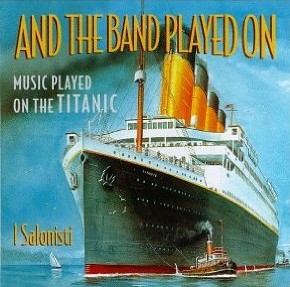 |
Titanic's Band
- "And the Band Played On"
One of the most famous stories of Titanic
is of the band. The entirety of the Ship's band was lost thanks in
large part to their heroic effort to calm the passengers. Led by
bandleader Wallace Hartley, they played music on the boat deck of
the Titanic throughout the night right up to the bitter end. It is
rumored that they played the hymn "Nearer, My God, to Thee" as their
finale.
Titanic's eight-member band, led by Wallace Hartley, had assembled
in the first-class lounge in an effort to keep passengers calm and
upbeat. Later they would move on to the forward half of the boat
deck. The band continued playing music even when it became apparent
the ship was going to sink.
There has been much speculation about what their last song was.
Since none of the band members survived the sinking, this is mostly
guesswork. Some witnesses said the final song played was the hymn
"Nearer, my God, to Thee." However, there are three versions of this
song in existence and no one really knows which version, if any, was
played.
|
Hartley
reportedly said to a friend if he was on a sinking ship
"Nearer, My God, to Thee" would be one of the songs he would
play.
Walter Lord's book
A Night to Remember
popularized wireless operator Harold Bride’s account that he
heard the song "Autumn" before the ship sank.
It is considered
Bride either meant the hymn called "Autumn" or "Songe
d'Automne," a popular ragtime song of the time. Others
claimed they heard "Roll out the Barrel."
The sad plight of Hartley and the
entire band is one of the most enduring images of the
Titanic story. Their grace and extreme nobility is
recognized by everyone as a magnificent display of
character.
Hartley's story is particularly
poignant because he was engaged to be married at the end of
the trip. Certainly her face had to be in his
imagination as he played on during the tragedy.
|
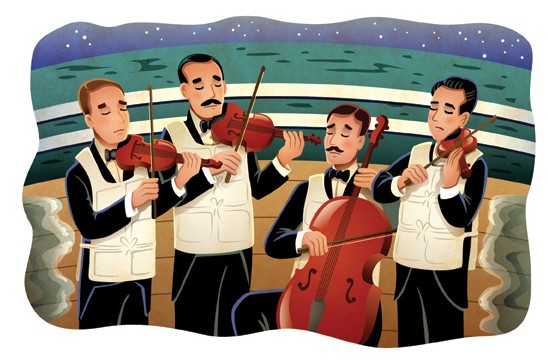 |
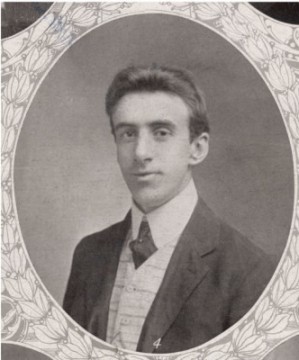 |
Whilst serving on the
Mauretania, the employment of Cunard musicians was transferred to
the music agency C.W. & F.N. Black, which supplied musicians for
Cunard and the White Star Line. This transfer changed Hartley's
onboard status, as he was no longer counted as a member of the crew,
but rather as a passenger, albeit one accommodated in second-class
accommodation at the agency's expense. It later transpired that
neither the shipping company nor the music agency had insured the
musicians, with each claiming it was the other's responsibility.
In April 1912, Hartley was assigned to be the bandmaster for the
White Star Line ship RMS Titanic. He
was at first hesitant to again leave his fiancée, Maria Robinson, to
whom he had recently proposed, but Hartley decided that working on
the maiden voyage of the Titanic would give him possible contacts
for future work.
Hartley's body
was one of those recovered and identified. Considered a
hero, his funeral in England was attended by thousands.
One of the musician's
family got billed after the disaster for the clothes he wore that
horrible day. The total cost came to 14 shillings, 7 pence. That's
$3.50 in American money, approximately $58.75 today.
This was the final insult. After the
bravery displayed by the band, the company's disrespect was
difficult to fathom.
|
Lifeboats
No single aspect
regarding the huge loss of life from the Titanic disaster
has provoked more outrage than the fact that the ship did
not carry enough lifeboats for all her passengers and crew.
This is partially due to the fact that an outdated trade law
required a minimum of 16 lifeboats for ships of the
Titanic's size—meaning that the ship was legally required to
carry only enough lifeboats for less than half of its
capacity. Actually, White Star Line exceeded the regulations
by including four more collapsible lifeboats—making room for
slightly more than half the capacity.
It was
anticipated during the design of the ship that the British
Board of Trade might require an increase in the number of
lifeboats at some future date. Therefore lifeboat davits
capable of handling up to four boats per pair of davits were
designed and installed, to give a total potential capacity
of 64 boats. The additional boats were never fitted. It is
often alleged that J. Bruce Ismay, the President of White
Star, personally stopped the installation of these
additional boats to maximize passenger promenade area on the
boat deck.
Of course all readers continue to
stare at the shortage of lifeboats with incredulity.
The only way to make any sense is to understand the thinking
of that age. The Titanic was assumed to be so superior
in its design that not only was it considered "unsinkable",
if something truly catastrophic did happen, it wasn't
supposed to sink as fast as it did.
At
the time, the belief in the shipbuilding industry was that
lifeboats would simply be used to ferry passengers to another ship
and disembark them, then return to a stricken liner for more
passengers.
The lack of
lifeboats was not the only cause of the tragic loss of
lives. After the collision with the iceberg, one hour was
spent to evaluate the damages, recognize what was going to
happen, inform first class passengers, and lower the first
lifeboat. Afterward, the crew worked quite efficiently,
taking a total of 80 minutes to lower all 16 lifeboats.
Since the crew was divided in two teams, one on each side of
the ship, an average of 10 minutes of work was necessary for
a team to fill a lifeboat with passengers and lower it. Only
10 minutes after the last lifeboat was lowered, the stern
rose out of water, suggesting that it would not have been
possible to lower any more lifeboats, if any were remaining.
Yet another
factor in the high death toll that related to the lifeboats
was the reluctance of the passengers to board the lifeboats.
They were, after all, on a ship deemed to be unsinkable.
Because of this, some lifeboats were launched with far less
than capacity, the most notable being Lifeboat 1, with a
capacity of 40, launched with only twelve people aboard,
with only two women and no children.
The Senseless Loss of Life
Amidst the hype surrounding
the launch of this new super ship, the phrase rang out:
"The Titanic is unsinkable!
Even God Himself couldn't sink this ship!!"
Titanic
was the largest passenger steamship
ever built
at the time. Thanks to improvements in
engineering design, the ship was
said to be unsinkable.
Sadly the iceberg proved
that assumption incorrect. The shock of
hearing the invincible Titanic had sunk was profound.
People could not comprehend the enormity of
impossible outcome.
The enormity of the surprise
was
so that
the Titanic became a symbol of failure when failure
is impossible.
The disaster became part of our
language, today one hundred years later, every time something goes
wrong, we refer to it as a "Titanic Disaster".
When a sports team loses a game when it is heavily
favored, we call it a
"Titanic Upset".
|
 |
The sinking of the Titanic was
a double tragedy. As if the loss of the ship
wasn't enough, there was a second tragedy waiting to
happen.
When it became apparent the
Titanic was in serious trouble,
the passengers rushed to the
lifeboats. At the time, they had no idea there
weren't enough lifeboats on board. Nor were
any of the officers revealing the truth. They
didn't want a riot on their hands.
At a point when about half the
lifeboats were lowered, the passengers began to
count the remaining lifeboats. They began to
wonder how they were going to fit all those
passengers into what was left.
They stared at the
remaining lifeboats in disbelief and growing horror. It slowly
began to dawn on them that there weren't enough
lifeboats to save everyone. Something was
wrong here. Very wrong.
The
Titanic carried only 20 lifeboats. These lifeboats had
a total capacity of 1,178 persons.
There were 2,223 people on
board. This meant
1,045 people were automatically
doomed to die.
As this grim reality took hold, it created a serious
unfolding drama. Some passengers accepted
their fate with grace and nobility. Other
passengers did whatever they could to get on the
lifeboats. Several men resorted to covering
their heads with women's shawls.
Adding to the tragedy, the death toll turned out to be much worse
than it should have been. 1,045 people were
doomed to die, but due to the ridiculous decision to
release several boats only half-full, 1,517
people
would perish.
Due to incompetence on the part of the
ship's staff in dealing
with the lifeboat situation, 472 more lives were
lost than necessary.
|
 |
This needless sacrifice
of life absolutely shocked the world. It was
one thing to be told this ship couldn't sink under
any circumstances, but to discover there weren't enough
lifeboats as well created a world-wide outrage.
The utter senselessness of the
shortage has continued to mystify people ever since. Over the years, people have asked
countless times,
"Why weren't there enough lifeboats?"
There were two reasons for the
shortage. First of all,
the Titanic wasn't supposed to sink. It was
invulnerable so why bother carrying extra
lifeboats? Thanks to a short-sighted decision
on the part of J. Bruce Ismay, president of the
White Star line, the extra lifeboats proposed by
Thomas Andrews, the designer, were scrimped to make
more room for luxury cabins and beautiful sightlines
of the ocean.
No one stood up to Ismay.
They shrugged their shoulders and figured it didn't
make much difference anyway. People were so certain of the
Titanic's majestic strength, no one seemed to
question the appalling lack of lifeboats.
Like some high-wire acts, the Titanic was allowed to
make its maiden voyage lacking an appropriate safety
net.
Oddly enough, this situation
was "legal" at the time. British shipping
officials permitted this situation even though deep
down they knew quite well there was no such thing as
an unsinkable ship.
Shipping Industry insiders
understood that the hype wasn't true. Yes,
under certain circumstances, the Titanic could sink.
For example, if it was hit by a torpedo in just the
right place, the ship could sink.
So the ship was designed to
deal with this threat. By creating 16 separate
compartments, theoretically they could seal off the
area
damaged by a torpedo and still stay afloat. Or in a
worst case scenario, the ship would take its
sweet time sinking. It would be days before
the Titanic finally went under.
In this case, there would be
plenty of time for another ship to come to the
Titanic's rescue. 20 lifeboats would be more
than sufficient to ferry the passengers back and
forth to the rescue ship.
Now you understand the
thinking behind the limited number of lifeboats.
In the unlikely event of an accident, the Titanic
was supposed to sink slowly... "Even God himself
couldn't sink this ship, but if He did, he couldn't
do it fast!"
The tragic collision with the
iceberg made it clear
that this line of thinking was absurd.
After the sinking,
no ship was ever again
allowed to set sail unless there were enough
lifeboats for everyone on the ship.
However, it wasn't just the
immensity of the lifeboat situation or the strange
one-in-a-million nature of the accident that took
down the ship. There were all sorts of
curious circumstances surrounding
the tragedy that left people hungry for more
details. For example, why couldn't the Titanic
have simply sailed around the iceberg? When
they learned the ship was going too fast, people
felt puzzled. When they further learned they
were going fast at night without any kind of light
thanks to a new moon, they were even more perplexed.
When it finally revealed the
Titanic had received over 20 different warnings of
ice from different ships about a gigantic ice field
and monster icebergs, people were incredulous.
Weren't the officers of the Titanic professionals?
If so, why didn't they have the sense to slow down?
As these details and other curious facts emerged,
the mystery deepened. Nothing made any sense
at all.
As it stands, the individual
stories are so poignant and the cosmic themes
surrounding the disaster are so profound that even
after
100 years people still find their
imaginations riveted. No one can read the
story of the Titanic without a sense of incredulity.
It wasn't supposed to
happen... but it did.
Like the Biblical fall of
Goliath and the Mythological fall of Achilles, the
Titanic instantly became an enduring symbol for the
value of caution and common sense. The Titanic became a grim
reminder to all of humanity to never take anything
for granted again.
|
The Curious Story of Captain Lord
There is a very sad story from this night
that is not well-known. Almost everyone on the Titanic
could have been saved were it not for the appalling negligence of
a certain Captain Lord. He was the captain of a ship
anchored just six miles away that did nothing to help the
wounded ship despite an entire series of warning signals
sent by the Titanic.
Inquiries into
the disaster found that the Californian and its captain,
Stanley Lord, failed to give proper assistance to Titanic.
Testimony before the inquiry revealed that at 10:10 pm,
members of the Californian
observed lights of a ship to the south.
It was later agreed between Captain Lord and the
third officer (who had relieved Lord of duty at 10:10) that
this was a passenger liner.
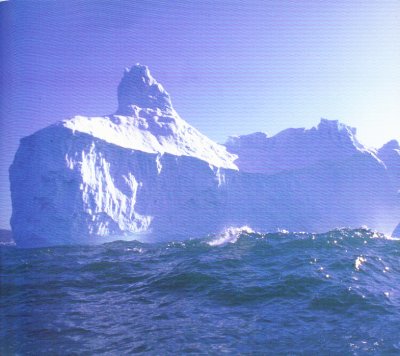 |
There
was a tragic sequence that night. At 11 pm the
Californian's wireless operator warned the
Titanic by radio of
nearby pack ice, explaining this was the
reason the Californian had stopped for the night.
However the Titanic's wireless operator,
Jack Phillips, was distracted. He brushed off the warning due
to a backlog of wires he was trying to send out. Moments
later, the Californian's wireless operator went to bed. He had
no backup, so the Californian could no longer be reached in case of
distress.
40 minutes later, the Titanic struck the
iceberg.
At 11:50
pm, the officer had watched this ship's lights flash out, as
if the ship had shut down or turned sharply, and that the port light
was now observed. Upon Lord's order,
5 Morse signals were sent to the Titanic
between 11:30pm and 1:00am. None of them
were acknowledged. (In testimony, it was stated that
Californian's Morse lamp had a range of about four miles.)
Unfortunately it was later determined that the Titanic was six miles
away, so the Morse signals did no good.
|
Captain Lord
retired at 11:30 pm. At 1:15 am,
the second officer, now on duty, notified Lord that
the mystery ship had fired a
rocket, followed by four more. Lord
wanted to know if they were "company signals," that is,
colored flares used for identification. The second officer
said that he "didn't know,"
adding that the rockets were all white.
Captain Lord instructed the crew to continue to signal the
other vessel with the Morse lamp, and went back to sleep.
Three more rockets were observed at 1:50 and the second
officer noted that the ship looked strange in the water, as
if she were listing. At 2:15 am, Lord was notified that the
ship could no longer be seen. Lord asked again if the lights
had had any colors in them, and he was informed that they
were all white.
It was not till three hours later that the
Californian finally responded.
At 5:30 am, the first
officer awakened the radio operator, informed him that
rockets had been seen during the night, and asked that he
try to communicate with any ships. The Frankfurt
notified the operator of Titanic's loss, Captain Lord was
notified, and the ship set out for assistance.
The inquiries
found that Californian was much closer to Titanic than the
19½ miles (36 km) that Captain Lord had believed.
In fact, the Californian was likely to have been no
further than six miles away.
It was the conclusion of the board that Lord was at fault.
At a minimum, Lord should have awakened the wireless
operator the moment the presence of the
rockets were first reported to him and
tried to make contact.
Captain Lord could have acted sensibly to prevent a loss of
life, but he did not. He
lost his job and spent the rest of his life trying to clear
his name, an effort that proved to be futile. He went down
in history as the major scapegoat of the night.
Rick Archer's Note: There is
one other fact about Captain Stanley Lord that should be
taken into consideration.
On the night of 14 April 1912, as the
Californian approached a large ice field, Captain Lord
decided to stop around 10:21 PM and survey the situation.
This ice field, as it turned out, contained the particular
iceberg that would sink the Titanic. Captain Lord
decided it was far too dangerous to sail through such a
dangerous pack of ice in total darkness. So he ordered
the Californian to drop anchor and wait till morning before
trying again in the daylight.
As mentioned above, before turning in
for the night, he ordered his sole wireless operator, Cyril
Evans, to warn other ships in the area about the ice. When
reaching the Titanic, Evans tapped out "I say old man, we
are stopped and surrounded by ice."
The Californian was so close to the
Titanic that the message was very loud in the ears of
Titanic First Wireless Operator Jack Phillips, who angrily
replied "Shut up! Shut up! I am busy. I am working Cape
Race."
Earlier in the day the wireless
equipment aboard the Titanic had broken down and Phillips,
along with Second Wireless Operator Harold Bride, had spent
the better part of the day trying to repair it.
Now the Titanic wireless operators
were swamped with outgoing messages that had piled up during
the day. Phillips was exhausted after such a long day. Evans
listened in for a while longer as Phillips sent routine
traffic through the Cape Race relaying station before
finally turning in for bed after a very long day at around
11:30 PM.
Given the fact that Captain Lord had made
such a prudent decision to stop for the night while Captain
Smith of Titanic plunged through the identical ice field and
the fact that Captain Lord made a diligent effort to warn
every other ship in the area of the extreme, it seems a
shame that the public decided to make him the scapegoat for
the tragedy.
It is a shame that Lord wasn't more
curious about those flares, but it seems to me that the man
was treated far more harshly than he deserved. Life
can be very unfair sometimes.
J
Bruce Ismay
Joseph Bruce Ismay was an English
businessman who served as chairman and managing director of
the White Star Line of steamships. He came to international
attention as the highest-ranking White Star official among
the 706 survivors.
Ismay may have survived the disaster,
but his reputation didn't.
After being
picked up by the Carpathia, Ismay was led to the cabin
belonging to the ship's doctor. He
stayed there for the entire journey
back to New York. He ate nothing solid, received only
a single visitor, and was kept under the influence of
opiates.[
After the
disaster, Ismay was savaged by both the American and the
British press for deserting the ship while women and
children were still on board. Some papers called him the "Coward
Of The Titanic" or "J. Brute Ismay".
It was suggested that the White Star flag be changed
to a yellow liver.
Some ran negative
cartoons depicting him deserting the ship. The writer Ben
Hecht, then a young newspaperman in Chicago, wrote a
scathing poem contrasting the actions of Capt. Smith and
Ismay.
The final verse reads: "To hold your place in the
ghastly face of death on the sea at night is a seaman's job,
but to flee with the mob, is an owner's noble right."
|
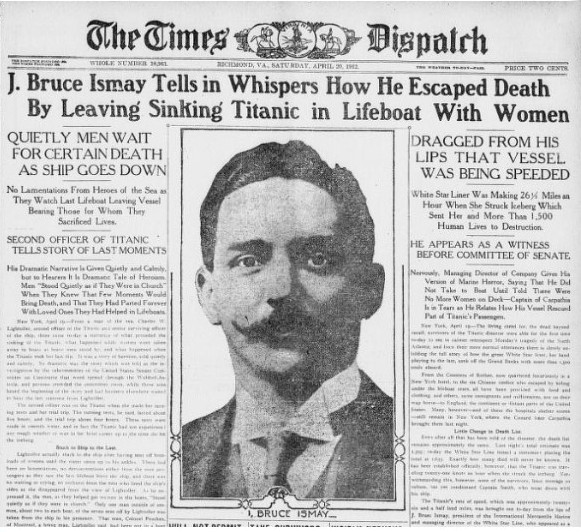 |
Some maintain Ismay followed the "women and children first"
principle, having assisted many women and children himself.
He and first-class passenger William Carter said they
boarded Collapsible C after there were no more women and
children near that particular lifeboat.
Carter's own
behavior and reliability, however, were criticized by Mrs.
Carter, who sued him for divorce in 1914; she testified
Carter had left her and their children to fend for
themselves after the crash and accused him of "cruel and
barbarous treatment and indignities to the person."
London society
ostracized Ismay and labeled him one of the biggest cowards
in history. Strong negative press came particularly from
newspapers owned by William Randolph Hearst, who some
claimed fostered a personal vendetta.
Ismay's
reputation was irreparably damaged.
Unwilling to face further public scorn, he maintained a low
public profile after the disaster.
|
|
|
|
|